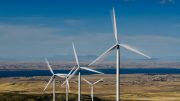Some climate change is now inevitable. Many communities are trying to adapt to the consequences.
It can be hard to adapt to any change, whether it touches your home, health, or livelihood. And now communities must confront climate change – the epic, sweeping force with the potential to disrupt every facet of life.
Many U.S. residents can already see the impacts of climate change from their own front doors, whether that view is clouded by smoke from frequent wildfires in the West or washed by torrential downpours in the Midwest and Northeast.
According to the Fourth National Climate Assessment, a sweeping report that outlines how climate change is affecting the United States, downpours have already grown more intense in some regions, and the risks from rising temperatures, drought, heat waves, and sea-level rise are growing. These impacts could threaten health, infrastructure, ecosystems, and entire social systems. And they are likely to intensify as carbon pollution accumulates in the atmosphere.
Scientists and policy leaders around the world have been urging cuts to heat-trapping carbon pollution. But because of the pollution that has already been released to the atmosphere over many years, reducing emissions is “no longer enough” to stave off the effects of climate change. As a result, many communities are working to adapt to the expected consequences of rising temperatures.
The 2015 Paris Climate Agreement included, for the first time, a global adaptation goal, and now many countries, states, and cities are developing climate adaptation plans.
So what does adaptation look like? It depends on where you are, but it can range from using goats to clear vegetation in California to raising roads in Florida. Here are seven ways communities are adapting to climate change.
1. Prepare for longer, more intense fire seasons
Drier, warmer conditions spell more wildfire for the West. Communities are adapting to this reality in a number of ways, like the California town putting goats to work clearing brush. The Mendocino County Youth Project is helping kids adapt to the aftermath of fires, offering a small support group for young wildfire survivors to help them heal.
2. Rise to the challenge of sea-level rise
Scientists expect global sea level will rise between eight inches and 6.6 feet by 2100, threatening low-lying coastal areas. So Miami Beach is “Rising Above” the challenge, putting millions of dollars into installing massive drain pipes and pumps, raising roads, and strengthening sea walls. Meanwhile in Georgia, volunteers are helping keep the Tybee Island 4H center above water by creating a “living shoreline” made of oyster shells to provide a buffer against storm surge and erosion.
3. Ensure disaster and public health plans account for more severe weather
Intense storms and extreme heat can have dire impacts on public health. So many communities are working to update infrastructure, real estate, and community planning strategies. The Red Cross, for example, is using climate science to prepare for disasters so it can better supply vulnerable communities with food, water and medical supplies. In Cedar Rapids, Iowa, the city is building a levee and flood wall system and elevating bridges to defend against future flooding. Meanwhile, because temperature extremes can lead to an array of health problems, cities like Emeryville, California, are coordinating cooling centers and working with unions to protect manual laborers during extreme weather.
4. Protect farms and the food supply from climate impacts
Temperature swings, prolonged drought, extreme storms, and other climate impacts are threatening long-standing farming practices. So farmers and agricultural experts are digging up other approaches, from investing in irrigation systems that help address drought to developing new crop varieties that may be better adapted to changing conditions. At Dickinson College Farm in Pennsylvania, for example, farmers are growing native trees in cattle pastures, a practice called silvopasture. As the climate warms, the shade of trees can help protect the animals from heat.
5. Protect air quality
Climate change can lead to more tiny particles and allergens in the air, which can harm the respiratory and cardiovascular systems. So many communities are working to clean up the air. For example, Phoenix high school students have convinced their school board to purchase its first electric school bus. The bus emits zero tailpipe emissions; it’s a small but important step toward cleaning up air pollution.
6. Prioritize climate justice
Climate impacts often exacerbate existing inequities, because lower-income and other marginalized people are often disproportionately affected by extreme weather, worsened air pollution, and other climate impacts. Indigenous communities and others who live close to the land are also among the hardest hit by climate change. Prioritizing adaptation efforts that explicitly help vulnerable populations will contribute to a more equitable future, according to the Fourth National Climate Assessment. For example, in Harlem, one nonprofit is advocating for affordable in-home air conditioning for low-income seniors who may not be able to get to a cooling center during a heat wave.
7. Prepare for managed retreat
Sometimes people really can’t go home again, whether to a neighborhood lost in a fire or threatened by rising sea levels. The result is the new notion of “managed retreat” – giving up on adapting to climate impacts in some places. Some have already made this choice, like the Biloxi-Chitimacha-Choctaw tribe, whose low-lying island home has lost 98% of its land. Tribal leaders are leading a relocation to a larger settlement on higher ground.
The role of cutting carbon pollution
Even as communities attempt to adapt to climate change, many are also working to reduce the amount of heat-trapping carbon pollution they create in the first place. The latter approach is known as “mitigation.”
Burnsville, Minnesota, for instance, has slashed emissions by 30% since 2005. Meanwhile in San Diego, a group of commercial building owners have pledged to cut energy use, water use, and transportation emissions in half by 2030. And more than 100 U.S. cities have pledged to transition to 100% renewable energy.
Climate experts agree that although it’s too late to avoid some negative consequences of a warming climate, it’s not yet too late to avoid the most severe impacts. Reducing the severity of climate warming will make it easier for communities to adapt, so adaptation and mitigation must go hand in hand.
Dec 30, 2019
by Daisy Simmons
Originally published by Yale Climate Connections under Creative Commons license





